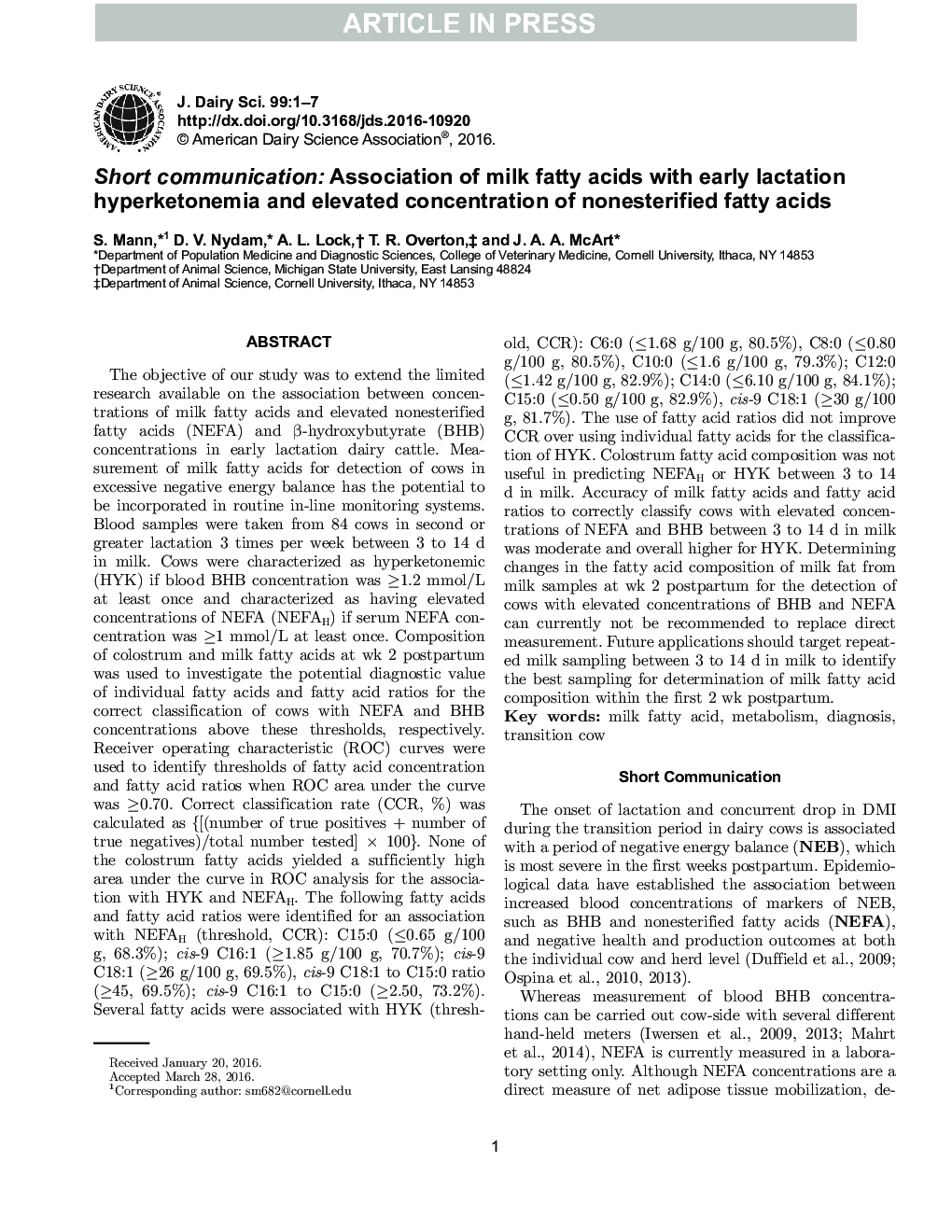| کد مقاله | کد نشریه | سال انتشار | مقاله انگلیسی | نسخه تمام متن |
|---|---|---|---|---|
| 10973681 | 1108017 | 2016 | 7 صفحه PDF | دانلود رایگان |
عنوان انگلیسی مقاله ISI
Short communication: Association of milk fatty acids with early lactation hyperketonemia and elevated concentration of nonesterified fatty acids
ترجمه فارسی عنوان
ارتباط کوتاه: ارتباط اسید های چرب شیر با هیپرکلئونمی زودهنگام شیردهی و افزایش غلظت اسید های چرب غیر اسیدهای چرب
دانلود مقاله + سفارش ترجمه
دانلود مقاله ISI انگلیسی
رایگان برای ایرانیان
کلمات کلیدی
اسید چرب شیر متابولیسم تشخیص، انتقال گاو،
موضوعات مرتبط
علوم زیستی و بیوفناوری
علوم کشاورزی و بیولوژیک
علوم دامی و جانورشناسی
چکیده انگلیسی
The objective of our study was to extend the limited research available on the association between concentrations of milk fatty acids and elevated nonesterified fatty acids (NEFA) and β-hydroxybutyrate (BHB) concentrations in early lactation dairy cattle. Measurement of milk fatty acids for detection of cows in excessive negative energy balance has the potential to be incorporated in routine in-line monitoring systems. Blood samples were taken from 84 cows in second or greater lactation 3 times per week between 3 to 14 d in milk. Cows were characterized as hyperketonemic (HYK) if blood BHB concentration was â¥1.2 mmol/L at least once and characterized as having elevated concentrations of NEFA (NEFAH) if serum NEFA concentration was â¥1 mmol/L at least once. Composition of colostrum and milk fatty acids at wk 2 postpartum was used to investigate the potential diagnostic value of individual fatty acids and fatty acid ratios for the correct classification of cows with NEFA and BHB concentrations above these thresholds, respectively. Receiver operating characteristic (ROC) curves were used to identify thresholds of fatty acid concentration and fatty acid ratios when ROC area under the curve was â¥0.70. Correct classification rate (CCR, %) was calculated as {[(number of true positives + number of true negatives)/total number tested] à 100}. None of the colostrum fatty acids yielded a sufficiently high area under the curve in ROC analysis for the association with HYK and NEFAH. The following fatty acids and fatty acid ratios were identified for an association with NEFAH (threshold, CCR): C15:0 (â¤0.65 g/100 g, 68.3%); cis-9 C16:1 (â¥1.85 g/100 g, 70.7%); cis-9 C18:1 (â¥26 g/100 g, 69.5%), cis-9 C18:1 to C15:0 ratio (â¥45, 69.5%); cis-9 C16:1 to C15:0 (â¥2.50, 73.2%). Several fatty acids were associated with HYK (threshold, CCR): C6:0 (â¤1.68 g/100 g, 80.5%), C8:0 (â¤0.80 g/100 g, 80.5%), C10:0 (â¤1.6 g/100 g, 79.3%); C12:0 (â¤1.42 g/100 g, 82.9%); C14:0 (â¤6.10 g/100 g, 84.1%); C15:0 (â¤0.50 g/100 g, 82.9%), cis-9 C18:1 (â¥30 g/100 g, 81.7%). The use of fatty acid ratios did not improve CCR over using individual fatty acids for the classification of HYK. Colostrum fatty acid composition was not useful in predicting NEFAH or HYK between 3 to 14 d in milk. Accuracy of milk fatty acids and fatty acid ratios to correctly classify cows with elevated concentrations of NEFA and BHB between 3 to 14 d in milk was moderate and overall higher for HYK. Determining changes in the fatty acid composition of milk fat from milk samples at wk 2 postpartum for the detection of cows with elevated concentrations of BHB and NEFA can currently not be recommended to replace direct measurement. Future applications should target repeated milk sampling between 3 to 14 d in milk to identify the best sampling for determination of milk fatty acid composition within the first 2 wk postpartum.
ناشر
Database: Elsevier - ScienceDirect (ساینس دایرکت)
Journal: Journal of Dairy Science - Volume 99, Issue 7, July 2016, Pages 5851-5857
Journal: Journal of Dairy Science - Volume 99, Issue 7, July 2016, Pages 5851-5857
نویسندگان
S. Mann, D.V. Nydam, A.L. Lock, T.R. Overton, J.A.A. McArt,
